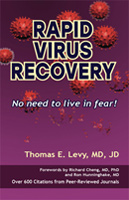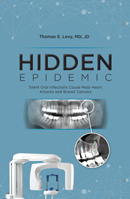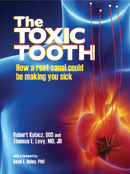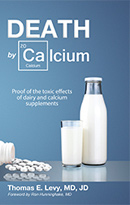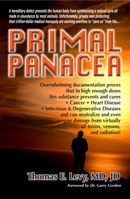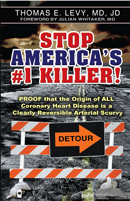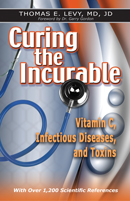Health E-Bytes
Health E-Bytes
Issue No. 9
June, 2005
THE MANY FACES OF VITAMIN C
A question that has been presented to me numerous times since the publication of my book, Curing the Incurable: Vitamin C, Infectious Diseases, and Toxins, is "What kind of vitamin C should I take, and why?" It is a very good question, indeed, as the variable effects on both short-term and long-term clinical outcomes can be dramatic.
It should first be emphasized that all of the forms of vitamin C share the characteristic of having a positively-charged cation and a negatively-charged anion in the dissolved form. Ascorbic acid is the hydrogen ion with the ascorbate anion; sodium ascorbate is the sodium ion with the ascorbate anion; calcium ascorbate is the calcium ion with the ascorbate anion; and so on. It is now readily apparent that all forms of vitamin C share the characteristic of having the ascorbate anion. In fact, it is the ascorbate anion that is the electron-donating, clinically active portion of all vitamin C preparations. However, the companion cations can have significant biological impacts as well, and this needs to be considered when choosing the best forms of supplementation for both short-term and long-term needs.
Mineral Ascorbates
The lion's share of all forms of vitamin C come as mineral ascorbates. The most common mineral ascorbates used in vitamin C supplementation include the following:
Sodium ascorbate
Calcium ascorbate
Magnesium ascorbate
Potassium ascorbate
Manganese ascorbate
Zinc ascorbate
Molybdenum ascorbate
Chromium ascorbate
Sodium ascorbate is probably the best and certainly the least expensive of the mineral ascorbates for regular supplementation at relatively high doses (six grams or more daily). Many doctors and patients fear the regular dosing of sodium, however, due to the long-standing medical admonition to minimize sodium intake, especially for hypertension and cardiac failure patients. Indeed, sodium chloride (table salt) has long been known to facilitate fluid retention (increased plasma volume), a state that directly aggravates hypertension and heart failure. However, it appears that only sodium really results in significant fluid retention when administered with the chloride anion. Sodium when given with the anions citrate, ascorbate, or bicarbonate does not appear to adversely affect hypertension or to increase blood volume. Because of these findings, it has been directly suggested that the concept of "sodium-dependent" hypertension should be changed to "sodium chloride-dependent" hypertension (Kurtz and Morris, 1983; Kurtz et al., 1987). Anecdotally, I have never found multi-gram doses of sodium ascorbate to adversely affect blood pressure or blood volume status. However, since there always appear to be exceptions to every rule in biology, anyone who notices elevated blood pressures or ankle edema after high doses of sodium ascorbate would probably be well-advised to supplement with a different form of vitamin C.
Calcium ascorbate is currently a very popular form of vitamin C supplementation. In addition to being directly labeled as calcium ascorbate, this form of vitamin C is also marketed as an "ester" form of vitamin C or a "buffered" form of vitamin C. Much of the popularity of this form of vitamin C comes from the fact that many people are looking for extra sources of calcium on a daily basis in addition to taking their vitamin C. With some minor variability, these products typically deliver approximately 100 mg of calcium for every 800 to 900 mg of ascorbate given. Also, the 100 mg or so of calcium with each gram of product usually has a very high degree of absorption when compared to other common forms of calcium supplementation, such as calcium chloride or calcium bicarbonate (Tsugawa et al., 1999).
However, the calcium-delivering properties of calcium ascorbate are precisely the best reasons for avoiding this product. Although it appears from the early work of Weston A. Price, D.D.S. that acutely raising the ionic calcium levels in the blood can greatly improve the acute phases of healing in damaged tissues, this does not address what the long-term consequences of calcium administration may entail. In fact, it appears that the bulk of the scientific data supports the concept that the vast majority of the older population is massively overdosed on calcium and legitimately suffering from calcium toxicity. We continue to be stressed with warnings of increased risk of osteoporosis while the data clearly shows that most deaths in patients with osteoporosis relate to the vascular system and not the bones (Kruger and Horrobin, 1997). Furthermore, excess calcium in the coronary arteries, one marker of long-term calcium overdosage, is also directly correlated to increased risk of heart attack (Raggi et al., 2003), increased incidence of chronic degenerative disease (Arad et al., 2001; Christian et al., 2003; Kiryu et al., 2003; Wong et al., 2003), and increased degree of overall "all-cause mortality" (Shaw et al., 2003).
So, if you are a older chronic calcium supplement taker, just be aware that there are negatives to this practice. The chance of dying from an osteoporotic fracture doesn't remotely approach the chances of dying from a heart attack, cancer, or another chronic degenerative disease. Furthermore, it is far from clear that the traditional treatment approach to osteoporosis significantly affects the likelihood of a subsequent fracture. The scientific evidence, however, is very clear that supplemental calcium often fuels the progression of atherosclerosis, with the expected increased chance of heart attack.
If the above does not convince you that supplemental calcium, with very rare exceptions, should be completely avoided, at least start tracking your calcium accumulations. The coronary artery CAT scan should show no calcium. Check it. Your heart should not be calcifying. Check your ECHOcardiogram. Hair analysis should not show excess calcium. Check it. If any or all of these tests are positive for calcium, you should be especially concerned about dumping still more supplemental calcium into your blood and body on a daily basis.
Magnesium ascorbate is another significant mineral ascorbate. Unlike the other mineral ascorbates (except for sodium ascorbate) it is very difficult to overdose on this form of ascorbate. This is because the magnesium cation is very bioavailable and very effective in reversing the damage done by excess calcium, a condition shared by most older individuals. Bioavailable magnesium (as ascorbate or as magnesium-amino acid chelates; NOT the commonly taken magnesium oxide form) is very effective in mobilizing abnormally deposited calcium throughout the body. As such, it is one of the most effective (and still least utilized) treatments available for osteoporosis.
While there is nothing wrong with taking large amounts of magnesium ascorbate, it is more economical to take large doses of bioavailable magnesium and sodium ascorbate separately to obtain the optimal effects of both these supplements.
Potassium, manganese, zinc, molybdenum, and chromium ascorbates are additional mineral ascorbates. All of the cations are desirable as supplements, but they can be easily be overdosed if they are used to deliver multi-gram doses of ascorbate.
Ascorbyl Palmitate
Ascorbyl palmitate is another form of vitamin C that is somewhat unique in that it has both water-soluble and fat-soluble qualities. It is touted by some as a superior delivery form of vitamin C as ascorbate into the body. This has not really been clearly proven, and even if it were, ascorbyl palmitate would be a very expensive way to provide daily multi-gram doses of ascorbate. The fat-soluble qualities of ascorbyl palmitate do make it a good form of vitamin C to include in various skin creams and other dermatological preparations.
Liposome-encapsulated Ascorbate
Liposomes were first proposed as a unique drug delivery system approximately 35 years ago (Bangham, 1995; Gregoriadis, 1995). One of the primary reasons for utilizing a liposome-encapsulation delivery system is to assure a near complete absorption of the encapsulated nutrient or drug into the bloodstream. The physical qualities of the liposome also eliminate the need for digestive activity before absorption.
Anecdotally speaking, I have taken a liposome-encapsulated form of ascorbate and found that it is virtually impossible to induce the "C-flush" effect that can be seen with large enough doses of the mineral ascorbates, most commonly sodium ascorbate and calcium ascorbate. Furthermore, it appears that the enhanced absorption along with the phospholipid dose absorbed at the same time has uniquely positive clinical benefits.
My Current Recommendations
For the reasons mentioned above, I never recommend the regular ingestion of vitamin C as calcium ascorbate. The remaining mineral ascorbates are acceptable forms of vitamin C supplementation, but one can risk overdosing the cations if multi-gram doses of these forms of vitamin C are taken, with the exceptions of the sodium and magnesium ascorbates.
For regular daily supplementation, sodium ascorbate is an economical, well-tolerated form of vitamin C. While many wish to avoid the "C-flush" effect, it appears to be a very good way to keep the gut relatively detoxified and clean. For those wishing to have a near-complete absorption of their vitamin C dose, the liposome-encapsulated form of vitamin C is optimal.
For acute infectious and toxic states, I still recommend getting intravenous sodium ascorbate, usually at doses of 50 grams or more over several hours for most individuals. However, I would also recommend adding the liposome-encapsulated form of vitamin C orally at the same time. If the intravenous sodium ascorbate is not available, I recommend taking sodium ascorbate to bowel tolerance, and then taking the liposome-encapsulated form of vitamin C, several grams hourly, guided by symptoms and clinical response to determine subsequent dosing.
Resources for Liposomal Vitamin C
More information about liposomal vitamin C can be found at www.LivOnLabs.com. If you are a health professional and express an interest in acquiring liposomal vitamin C for resale to your patients, contact LivOn Labs at 1-888-352-0214 or sending an email to service@livonlabs.com.
Bibliography
Arad, Y., D. Newstein, F. Cadet, M. Roth, and A. Guerci (2001) Association of multiple risk factors and insulin resistance with increased prevalence of asymptomatic coronary artery disease by an electron-beam computed tomographic study. Arteriosclerosis, Thrombosis, and Vascular Biology 21(12):2051-2058.
Bangham, A. (1995) Surrogate cells or Trojan horses. The discovery of liposomes. Bioessays 17(12):1081-1088.
Christian, R., D. Dumesic, T. Behrenbeck, A. Oberg, P. Sheedy, and L. Fitzpatrick (2003) Prevalence and predictors of coronary artery calcification in women with polycystic ovary syndrome. The Journal of Clinical Endocrinology & Metabolism 88(6):2562-2568.
Gregoriadis, G. (1995) Engineering liposomes for drug delivery: progress and problems. Trends in Biotechnology 13(12):527-537.
Kiryu, S., V. Raptopoulos, J. Baptista, and H. Hatabu (2003) Increased prevalence of coronary artery calcification in patients with suspected pulmonary embolism. Academic Radiology 10(8):840-845.
Kruger, M. and D. Horrobin (1997) Calcium metabolism, osteoporosis and essential fatty acids: a review. Progress in Lipid Research 36(2-3):131-151.
Kurtz, T. and R. Morris, Jr. (1983) Dietary chloride as a determinant of "sodium-dependent" hypertension. Science 222(4628):1139-1141.
Kurtz, T., H. Al-Bander, and R. Morris, Jr. (1987) "Salt-sensitive" essential hypertension in men. Is the sodium ion alone important? The New England Journal of Medicine 317(17):1043-1048.
Raggi, P., B. Cooil, L. Shaw, J. Aboulhson, J. Takasu, M. Budoff, and T. Callister (2003) Progression of coronary calcium on serial electron beam tomographic scanning is greater in patients with future myocardial infarction. The American Journal of Cardiology 92(7):827-829.
Shaw, L., P. Raggi, E. Schisterman, D. Berman, and T. Callister (2003) Prognostic value of cardiac risk factors and coronary artery calcium screening for all-cause mortality. Radiology 228(3):826-833.
Tsugawa, N., T. Yamabe, A. Takeuchi, M. Kamao, K. Nakagawa, K. Nishijima, and T. Okano (1999) Intestinal absorption of calcium from calcium ascorbate in rats. Journal of Bone and Mineral Metabolism 17(1):30-36.
Wong, N., M. Sciammarella, D. Polk, A. Gallagher, L. Miranda-Peats, B. Whitcomb, R. Hachamovitch, J. Friedman, S. Hayes, and D. Berman (2003) The metabolic syndrome, diabetes, and subclinical atherosclerosis assessed by coronary calcium. Journal of the American College of Cardiology 41(9):1547-1553.
Copyright © 2005 by Thomas E. Levy, M.D., J.D.
All Rights Reserved; Reproduction Permitted only with Acknowledgement and of the Entire Document
Other Issues
Issue No. 1 - October, 2001
Bioterrorisms: Beyond Vaccinations and Antibiotics
Issue No. 2 - November, 2001
Bioterrorism: Beyond Antrhax and Smallpox
Issue No. 3 - January, 2002
Artificial Water Flouridtion: More Than Just Flouride
Issue No. 4 - May, 2002
Some Observations on "Enriched" Food Products
Issue No. 5 - October, 2002
Electrons, Toxins and Disease
Issue No. 6 - July, 2003
Pulsed Intravenous Vitamin C (PIVC) Therapy
Issue No. 7 - December, 2003
Vitamin C and Severe Influenza: a case report
Issue No. 8 - December, 2004
Vitamin C, Pumonary Embolism, and Cali, Colombia

